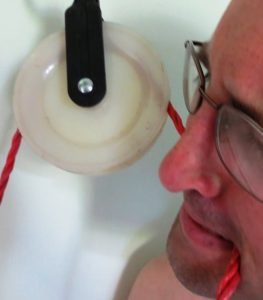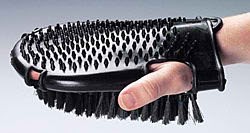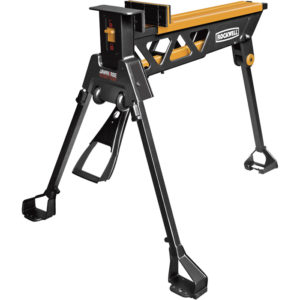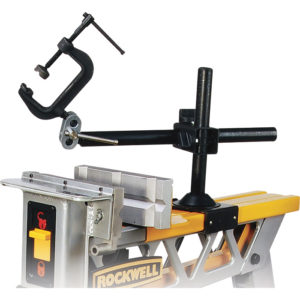Flinging hammers. Smashing mugs. Hugging posts. Stomping pedals. Clenching teeth.

This could sound like a temper tantrum, but it’s not. This is a tradesman in his shop or on the work site getting the job done in spite of impaired grip strength. Sometimes a hammer or mug slips out of his grip. Sometimes he must reach around a post with one arm to wrap a chain, or bite a rope to pull a knot tight or step on a lever to secure materials. But all along, with the right tools in his box and new work methods in his mind, the job gets done.
Grip strength may be impaired by many different situations. Arthritis, nerve damage, poor circulation, amputation, spinal cord injury, stroke, repetitive motion injuries, multiple sclerosis, crushing trauma, and other disabling conditions weaken a person’s ability to grip and hold.
2 Ideas For Arthritic Hands: Mitt Scrub and Clamps
The biggest pain from working with arthritic hands is sustained grip on a small diameter handle or object. Both of these items reduce the need to grip small items. The mitt scrub allows scub brush action while keeping the palm and fingers flat. No more tightly gripping a handle while scrubbing. Clamps of all kinds hold parts and pieces and tools in a fixed position instead of doing the same thing with sore fingers. The foot operated work station is an incredibly flexible clamping system that can hold several items in place at once.


Workers with gripping disabilities will be able to use this mitt to clean and brush. It is designed to be a grooming mitt, but will work as a general purpose brush to use without grasping a handle. A two-sided mitt has nylon bristles for scrubbing, and the other side is nubbed for firmer scraping. It can be worn on either right or left hand.
Clamps
The Welding Station provides an infinitely adjustable C-clamp above the foot-operated clamp so that a fabricator or welder with one functional arm can securely position two parts while fastening them together. This is an ATTACHMENT to the foot operated workstation (sold SEPARATELY). The foot operated workstation allows a worker with arm amputation or impairment to use his foot to clamp items on a work platform.
Metal workers and fabricators usually use one arm to hold parts in position and another to hold a tool, grinder or welder. To position these parts when fabricating metal assemblies, it would require several clamps and careful positioning with two hands. With one arm injured or disabled, a worker needs to position the parts first in a secure, easily adjustable arrangement, then use the tool. This welding station is used in such situations, because parts can be adjusted and secured with one arm.
– See more at: http://disabilityworktools.com/foot-operated-workstation-welding-station/#sthash.1MpFEnvP.dpuf
A worker with arm amputation or impairment can use his foot to hold items on this work platform. To clamp materials to a work bench, the worker 

The Welding Station provides an infinitely adjustable C-clamp above the foot-operated clamp so that a fabricator or welder with one functional arm can securely position two parts while fastening them together. This is an ATTACHMENT to the foot operated workstation. The foot operated workstation allows a worker with arm amputation or impairment to use his foot to clamp items on a work platform.


